
Nobel Prizes in your pocket by Andi Q. '25
Computers are so cool omg this is why I’m a course 6
Do you ever stop to think about how incredible computers are? I don’t just mean software innovations like generative AI or the internet. I’m talking about the hundreds of billions of silicon transistors that form the brain of your computer, each engineered and manufactured to near perfection. If you think about it, the CPU inside your computer is basically sand that we taught to add numbers (much, much better than humans can do)! And don’t even get me started on other things like displays, memory, and batteries – all things necessary for the light from this paragraph to be hitting your eyeballs right now.
With the 2023 Nobel Prizes still fresh on everyone’s mind and today being National Nanotechnology Day, I wanted to take this opportunity to talk about a few Nobel-prize-winning discoveries (since the year 2000) that enable you to read this blog post.
Brilliant Displays of Science
Regardless of what display you’re using to read this blog post, it is almost certainly powered by one of the following three technologies with roots in the Nobel Prize in Chemistry or Physics. (Even if you’re using a CRT display for whatever reason, the 1905 Nobel Prize in Physics was awarded for the invention of the cathode ray tube.)
QLED Displays
Suddenly she is in a magical, technicolour world
Last week, MIT’s Professor Moungi Bawendi won the 2023 Nobel Prize in Chemistry for his work in synthesizing quantum dots – nanoparticles so tiny that their size determines properties like the colour of light they emit.
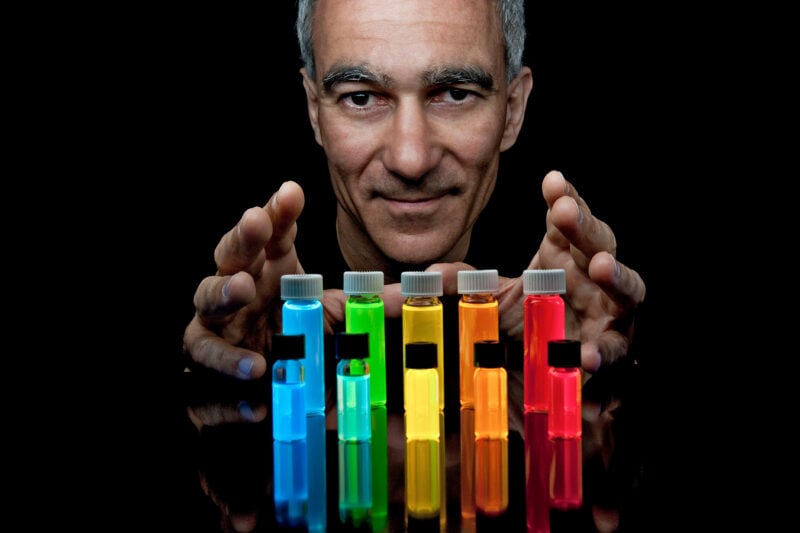
Professor Bawendi with an array of his famous quantum dots. I’ve heard he’s a really nice guy (he actually teaches an undergrad class about synthesizing quantum dots!), so I’m super happy for him :)
In my opinion, this year’s prize was one of the coolest Chemistry Nobel Prizes yet. Not only does the discovery involve pretty colours (always a plus in my books), but the prize was awarded to an MIT professor just a few days after I learned how quantum dots work in my Course 301 Materials Science & Engineering condensed matter physics class. They’re a neat demonstration of quantum mechanical effects and already have several commercial applications!
The most prevalent commercial application of quantum dots is in Samsung’s QLED (quantum LED) displays. Although the word “quantum” is synonymous with “we needed a science word to make our thing sound more impressive” these days (thanks, Marvel), “quantum LED” really does describe how these displays work! The exceptionally pure light that quantum dots emit makes them ideal candidates for modern display technologies.
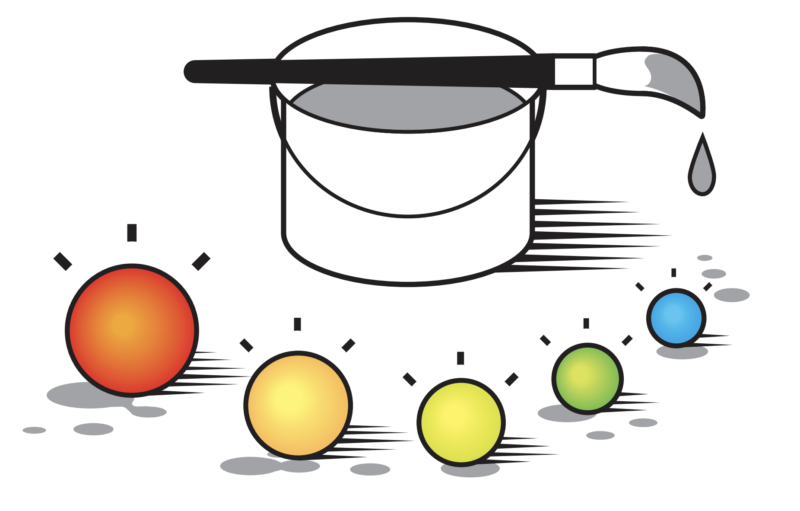
Illustration of quantum dots, © Johan Jarnestad/The Royal Swedish Academy of Sciences
Beyond display technologies, quantum dots have a bright future (pun intended) ahead of them. From more efficient solar cells to quantum computing, the opportunities for these miraculous nanoparticles to improve our lives seem endless!
OLED Displays
How can plastic become conductive?
In materials science, “conductive polymer” is somewhat of an oxymoron. Polymers are almost always insulators (i.e. they do not conduct electricity) because they’re held together by covalent bonds, which don’t allow electrons to move around easily.
Yet by introducing small amounts of foreign substances (known as “dopants”) like lithium or iodine, certain polymers see dramatic increases in their conductivities while maintaining their processibility and flexibility. In addition to conducting electricity, they can become transparent and emit light under a voltage. The discovery of these amazing materials, which are light and flexible like plastics but can conduct electricity like metals and semiconductors, was awarded the 2000 Chemistry Nobel Prize.
This serendipitous combination of electrical and optical properties has led to conductive polymers being used in OLED (organic LED) displays and flexible phone screens. Ever wonder why your phone’s touchscreen isn’t a mess of criss-crossing copper wires? You’ve got conductive polymers to thank for that.
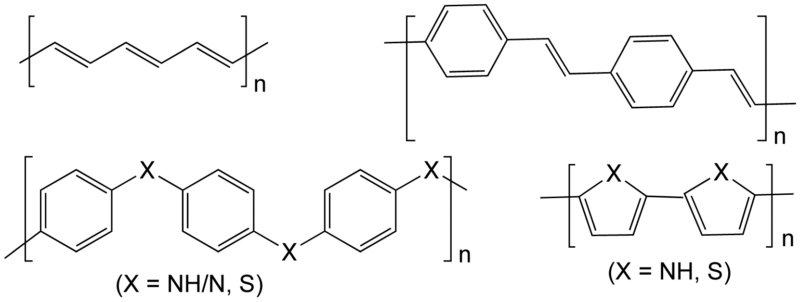
Wow, look at all these conductive polymers! I have no idea why these ones specifically are conductive, but they sure are fun to look at.
Blue LEDs
Incandescent light bulbs lit the 20th century; the 21st century will be lit by LED lamps
The 2014 Physics Nobel Prize was awarded for the invention of… blue LEDs. Yes, the same blue LEDs you can buy on Amazon for 7 cents each. You can find blue LEDs in any LED-powered light source that can emit white light (so pretty much every modern display), which goes against the idea that Physics Nobel Prizes are awarded for abstract, theoretical work with no significance for the general public. But the prevalence of these brilliant little devices shows just how important they are in today’s world.
Although the invention doesn’t seem super impressive by today’s standards (even undergrad students like me can probably fabricate a blue LED in a day), the first bright blue LED in the early 1990s marked one of, if not the most important breakthroughs in lighting technology. Red and green LEDs had existed for decades prior, but we could only shift away from wasteful incandescent light bulbs to energy-efficient LED lights thanks to the invention of the blue LED.
Masters of Light
On that note, let’s talk about two other important uses of light in computers – fiber optic communications and digital camera sensors, both of which won the 2009 Physics Nobel Prize.
Fiber Optics
The circulatory system that nourishes our communication society
The fiber optic cables carrying information around the world are probably directly responsible for you reading this blog post right now. They (quite literally) form the backbone of the internet, and for good reason too. They transmit information quickly and reliably over huge distances and are immune to the noise that often plagues electrical transmission lines. And they’re usually made out of regular silica glass02 The same glass your windows are made of instead of some exotic material that’s difficult to manufacture.

A map of major under-sea cables forming the backbone of the internet, © Greg Mahlknecht. If you unwind all of that into a single glass fiber, it would stretch over 1 billion km long!
At the very least, I wouldn’t have been able to publish this blog post without them (because then I would’ve had very slow WiFi, which would’ve made me rather sad).
Camera Sensors
A photographic camera for everyone
Admittedly, the 2009 Physics Nobel Prize was for the invention of CCD (charge-coupled device) sensors instead of the more modern CMOS (complementary metal-oxide semiconductor) sensors that most phone cameras use now. CCD technology uses the photoelectric effect03 Which one Albert Einstein his 1921 Physics Nobel Prize to sense the light hitting a massive array of pixels.
I still think it’s worth mentioning CCD sensors because they were the first commercially available, high-quality camera sensors and brought about the digital film revolution. And many modern DSLR cameras still use CCD sensors!
(Apparently, some people have strong opinions about which one of CCD and CMOS yields better image quality. I personally can’t tell the difference, but here’s a side-by-side comparison in case you can.)

Can you tell which picture was shot with CCD or CMOS? Because I can’t. (Seriously, I just pulled this picture from somewhere online and I don’t know which is which.)
Store and Release
These massive data streams would be practically useless if we couldn’t store stuff on your computer, be it retrievable information on a disk or power in a rechargeable battery. Luckily, there are also a few Nobel Prizes in those areas.
Magnetic Hard Drives
The whole world… in the pocket of each and everyone
Magnetism is kind of like the misunderstood and unloved sibling of electricity. Sure, it’s fun to play with magnetic toys, but there aren’t many things magnetism can do in computers that electricity can’t do better. There also aren’t that many magnetic materials around, and it’s extremely difficult to apply them at the same scale as modern electronics. Everyone has heard of electrons and electronics, but there’s no such thing as magnons or magnonics!
Just kidding, they do exist04 Technically, I'm talking about spintronics, but magnonics falls under that umbrella . And the discovery of giant magnetoresistance (GMR) – a quantum mechanical phenomenon where a magnetic material’s electrical resistivity greatly depends on its magnetic state – won the 2007 Physics Nobel Prize.
The use of GMR in magnetic hard drives is widely regarded as one of the first major applications of nanotechnology and has ushered in an age of cheap and high-density data storage. Without it, we wouldn’t have laptops or any modern machine learning applications, which require massive amounts of data to be effective.
Although magnetic hard drives are slowly being phased out in favour of faster and more reliable solid-state flash memory05 Flash memory relies on electron tunnelling, which is the subject of the 1973 Physics Nobel Prize , GMR still has uses in MRAM (magnetoresistive RAM) and other emerging applications of magnetism. I may be a bit biased because all my research is on magnetic materials and devices, but I’m hopeful about magnetic memory making a comeback in the future!
Lithium-ion Batteries
The right conditions for a wireless and fossil fuel-free society
Another oft-unsung hero that (quite literally) powers your computer (and a lot of other things) is the subject of the 2019 Chemistry Nobel Prize. Like the blue LED, we never really think about them, even though they’re everywhere. (That is, until a Tesla spontaneously combusts again, but I digress…)
There’s not much I can (or want to) say about them because… yeah, they’re batteries, so here’s a cute illustration from the Nobel Prize press release showing how they work:
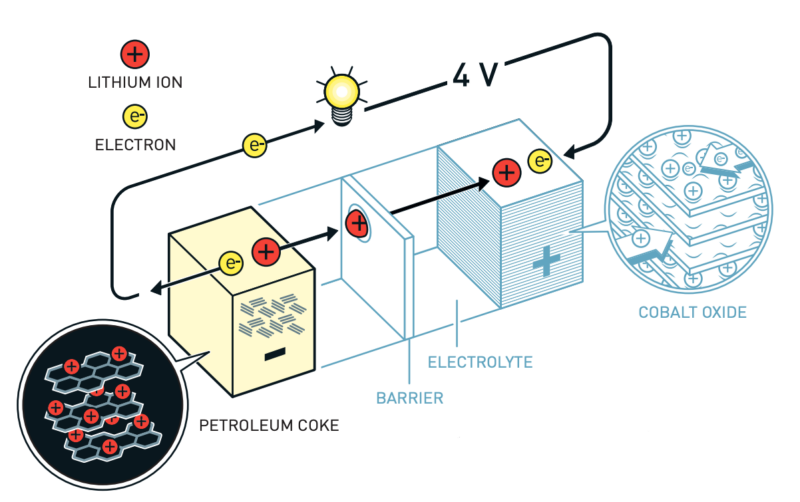
How a lithium-ion battery works. © Johan Jarnestad/The Royal Swedish Academy of Sciences
An Integrated World
Of course, I can’t end this blog post without talking about the basis of all modern microelectronics:
The Integrated Circuit
A market survey… showed that interest in a pocket calculator was negligible. After all, people had slide-rules!
Every single chip in your computer (unless you spilled a bag of Doritos or something over it) is an integrated circuit. Every single chip in your car, your microwave – pretty much any electronic device that does computation – is an integrated circuit. Our world would be completely unrecognizable without them, which is why the 2000 Physics Nobel Prize was awarded for the invention of the integrated circuit (IC).
The idea behind ICs is relatively straightforward – put all the components of a traditional electrical circuit on a single piece of silicon – but the devil is always in the details. Keep in mind that back in the 1950s when Jack Kilby and Robert Noyce invented the IC, they did not have computers to help them design anything, so everything had to be done painstakingly by hand.
Despite this challenge, they persisted and eventually succeeded. And thus began the birth of the modern computer. Over time, these ICs became progressively more powerful, and we eventually began using them to design even better chips. Almost as if a superintelligent AI started generating progressively more intelligent versions of itself, for better or for worse.
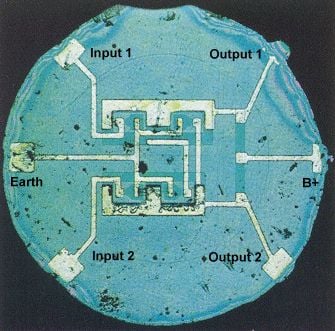
The first monolithic silicon IC chip, created by Robert Noyce. Although it doesn’t look super impressive, this invention would go on to change history.
I didn’t list any prizes before 2000, but that was just because I didn’t want this blog post to get uncontrollably long. I highly encourage you to browse the list of past physics and chemistry Nobel laureates – you’ll be amazed by how many of their discoveries eventually found their way into your computer!
- Materials Science & Engineering back to text ↑
- The same glass your windows are made of back to text ↑
- Which one Albert Einstein his 1921 Physics Nobel Prize back to text ↑
- Technically, I'm talking about spintronics, but magnonics falls under that umbrella back to text ↑
- Flash memory relies on electron tunnelling, which is the subject of the 1973 Physics Nobel Prize back to text ↑